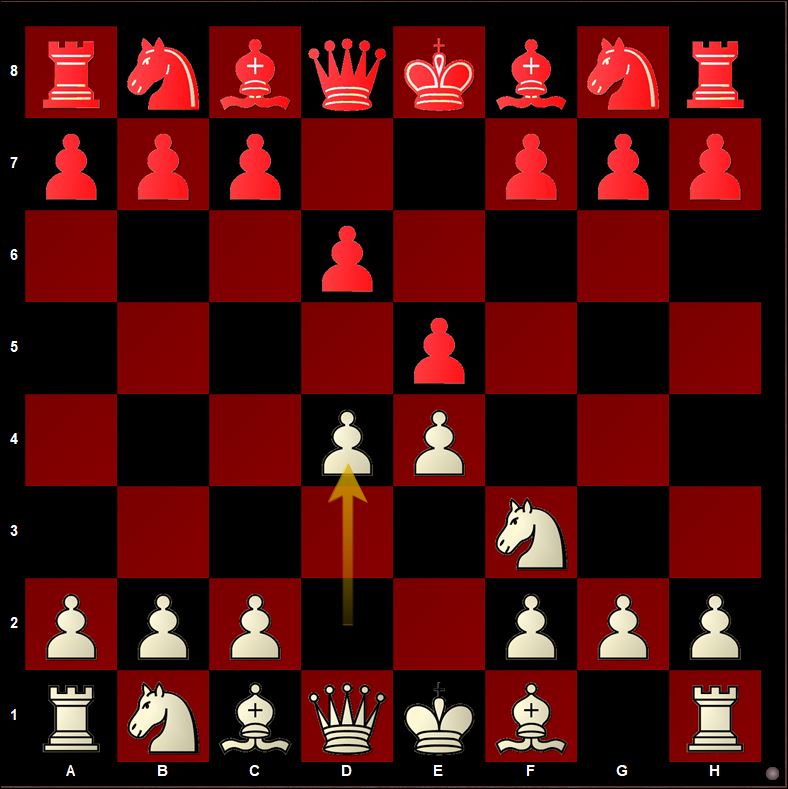
I think the Devil really exist… I was looking for material for creating my own repertoire against 1.e4 using 1…e5 as answer. In fact I wrote another article about it. Then I go to the Chessbase site to check if there was something new, and I don’t know how it happened, instead of going on the English version, I landed on the German version.
And the devil presented itself in the guise of this DVD, tempting me to return to play an opening I know very well, and which in my opinion has become outdated, because there are some problems to deal with some lines White can play.

I admit I don’t really speak German language. I did study it when I was young, because I did a lot of stupid stuff when I was young. In that time, Germany had the price of gas which was half of what we paid in Italy, when I went on summer vacation I would go to Germany because I could afford a hotel with the money I saved on gas and highways! But not only that, on the German highways there was no speed limit! It was like going on Formula One. And the funny thing is, there were a lot of Italians living there. Once I stopped in a city to ask for info, and the guy I asked to was an Italian living there. I had a blast, it was like being at home, he invited me to his restaurant, great Italian food and Italian language…just the signs and the names of the cities were strange…
In any case, I found this DVD which is not in English, but being the last update on the Scandinavian with Qd6, it’s quite interesting to me because I played it previously. I generally like the Chessbase DVDs, not because I believe I’ll learn some opening secrets, but because the guy who makes it, no matter if he’s a FM, IM, or a top GM, gives me the latest info upon that opening, with a selection of games, and ideas I can use in my own games.
GM Tiviakov made a DVD few years ago.
Then everyone noticed his good results with the Scandinavian, and they neutralized the lines he gave in the DVD, so it was time there was an update. On the other hand I do believe it’s important to open our minds to different languages, and authors, because this is the greatness of chess, I can go to Germany, Singapore, or Nigeria, and if the people I meet there are chess players, we are like family. And of course I love to see how chess is taught in other languages. I’d love to be like Fischer, who learned Russian. In that time it was essential, because most publications, and latest books were in Russian, today we are lucky most stuff is translated in English, but I’m sure we would become better chess players, and enjoy more chess, if we would learn Russian, an example which comes to mind is my friend Michelino (Mihail Marin)

who also learned Russian when he was young, and he definitely benefit a lot from such learning!
I began to write this article as a review of the DVD, but then the material, just for the sidelines, became too huge for one article, so I thought to split this article in 2 or 3 parts, because those who like me are interested in the Skandinavische, will be able to use the article as reference for knowing the main ideas, and what to play, against White’s latest theoretical discoveries.
Honestly I never heard of Mr. Martin Breutigam, so as chess player, when I want to know another chess player, the first thing I do is to open my Chessbase Megabase 2021, and put his name, and see some of his games.
There were more than 400 games played by Breutigam, whose rating is around 2300-2400 and has the IM title.
Obviously my first curiosity was if IM Breutigam played the Scandinavian, which as ECO is defined by B01. Here the games he played with this opening.
Obviously I watched many more games by Breutigam, like his shortest wins, or wins against GM level players etc. But since they are not relevant to this article, I’ll not include them.
The DVD opens with a general introduction to the many lines played by White against Qd6.
Then it continues with the “neibenvarianten” the more rare answers or better translated thanks to Holger as “Sidelines”, which we do need to know, because some opponents will try to surprise us with them, or in their not wanting to prepare theoretically against the Scandinavian, will play one of these sideline with such purpose.
In fact when playing against the Scandinavian and opening with 1.e4 I also used some of them, for example the Blackmar-Diemer gambit, which immediately asks Black how well prepared he is theoretically! 1.e4 d5 2.d4! now Black needs to decide if he wants to take 2…dxe4 or maybe enter a French 2…e6 or a Caro-Kann 2…c6.
Breutigam analyses some very interesting lines, for which I continuously refer to Megabase 2021 for finding games, and see how strong players treat such lines. In this way I avoid to re-invent the wheel, while gaining a lot of ideas on the main ways to play such lines. Strong players are those around 2400 and above. To reach that level they have created an opening repertoire, and polished it through hundred of battles in different tournaments. Here an example of a theoretical line shown by Breutigam in the beginning: 1.e4 d5 2.d4 dxe4 3.Nc3 Nf6 4.f3 Bf5 5.g4 nowadays thanks to chess computers, moves like this one, quite aggressive, are common. Hence the need to watch some games, and gain some understanding on how to fight such aggression! 5…Bg6 When I look for games in a certain line using the megabase 2021, I generally tend to look for the latest one played, and the strongest players playing the Black side (if the opening I was studying was for White, then I would use: strongest players for White side, which in this case is based on rating). These are a sample of games I found:
From the above sample of games, I gained the impression many times the White player was outplayed tactically, hence the need to keep our tactics sharp! That can only be done daily, through consistent training. Such training will open our eyes to the traps laid inside the games we watch, and we will not need an engine to show why a player played some moves, because it will be evident from our tactical-knowledge base.
Another line I found interesting was the following: 1.e4 d5 2.d4 dxe4 3.Nc3 Nf6 4.f3 Bf5 5.fxe4 Nxe4 6.Qf3 Nxc3 this position deserves some analysis, because the Qf3 is attacking B7 and the Bf5. Also in this case I search the games in Megabase, and try to understand if I’m able to win the game based on the evaluation given by Breutigam which maybe is based on engines or games played by strong players with this same line. The point here is the following, maybe I’m not as strong or good to technically win a game with such advantage, because today the defensive technique has improved a lot.
Notice I found also a game played by Caruana in 2005, when he wasn’t the 2800 rated player he is today!
Another interesting line is 1.e4 d5 2.Nf3 dxe4 3.Ng5 Bf5 4.Bc4 e6 5.Nc3 Nf6 6.Qe2 Nc6
Through the Skandinavische we can enter other openings color reversed. For example the Philidor is played after the moves: 1.e4 e5 2.Nf3 d6 3.d4

and now Black would play 3…Nf6 and if White takes on e5 it would continue this way: 4.dxe5 dxe5 5.Qxd8 Kxd8

at this point there are some interesting lessons one can learn from dealing with this position, especially about piece placement. However a big mistake, would be to consider such position a draw because the queens have been exchanged. Playing such position against an engine can open our eyes to the subtleties we need to learn.
White against the Skandinavische can play a similar Philidor position with color reversed after: 1.e4 d5 2.d3 dxe4 3.dxe4 Qxd1 4.Kxd1 e5 how should Black continue from here?

Breutigam gives the idea of playing Bc5 and Be6, likely depending on what White will play. In this case we must become interactive learners, because I know this type of opening can cause a lot of grief, if one is not ready to go for a lengthy positional war.
I returned to my Megabase 2021 and using such positions shown above I looked for 5 games lost by Black, 5 games won by Black, and 5 games drawn, now I have a sample of the main ideas, and possible mistakes from both sides. After watching many games I noticed often Black won in the endgame, hence one could win not because of skilled planning, but luck or having the opponent blundering in time trouble. Most endgames I saw were knights and pawns, one must like them, if they are the norm. I didn’t really see Black coming out of the opening with an advantage, hence this reversed Philidor is something White can play safely.
Yes, this is the nature of studying openings, we have not even entered the main 1.e4 d5 2.exd5 Qxd5 3.Nc3 Qd6, and have already seen dozen of games, and have a lot of stuff to remember or try against an engine, to see how much we grasped of the material.
Since I consider this article a review but also a reference for those who are serious about studying and playing the Skandinavische, then I will break the article in few parts, to avoid to make something which is too big for a browser to load.
Final Thoughts:
I’m glad I got this DVD, because I updated my theoretical knowledge of the Skandinavische, and refreshed those lines which are less used, and were kind of forgotten. While it was interesting to see the interpretation given by a lot of different players, the last word in chess improvement is always about ourselves. Now I need to go over my online and tournament games, with a new engine like Fat Fritz 2, to see if it can find some novel ideas to spring against White.
This article is not a review, is a reference, meaning everyone can use it to prepare before a tournament. Yes, 2-3 days or even a week before a tournament, watching the games I have included in this article will give the reader all the needed ideas and maneuvers in order to play the sidelines in the Skandinavische mit Qd6!
